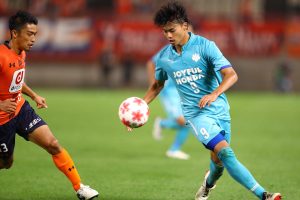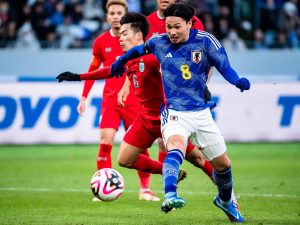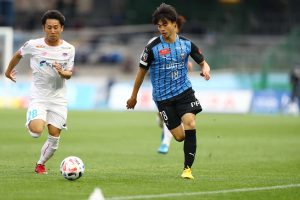
Daichi Kamada was playing for Sagan Tosu / photograph: Kenzaburo Matsuoka
Bukatsu, a youth system at school in Japan which has produced the likes of Daichi Kamada, Junya Ito, Ayase Ueda, Yuto Nagatomo
Japanese star footballers such as Brighton’s Kaoru Mitoma, Arsenal’s Takehiro Tomiyasu and Freiburg’s Ritsu Doan have, like their European counterparts, grown up in club youth academies before becoming professional.
But if you look at Japan’s squad for the Qatar World Cup, it shows that only 13 of the 26 registered players spent their youth years (U16 to U18) at club academies. For example, Daichi Kamada who has just moved to S.S. Lazio, Junya Ito of Stade Reims, Daizen Maeda of Celtic, Ayase Ueda who has just joined Feyenoord Rotterdam and even Yuto Nagatomo who used to play for Inter Milan, all were not from the youth academy of the J.League clubs. They all came from high school football clubs – sports and cultural activities after (sometimes before, in early morning) the classes at school are called “Bukatsu” in Japan, shortened words of “Kurabu Katsudou” (club activity in Japanese).
Looking back into Japan squad at each World Cup since 1998, the number of players from club academies has been increasing. In its first appearance in France in 1998, there were no academy players, and in 2002 there were five, including Junichi Inamoto. The number rose to 10 in 2014, but the number of players from club academies has never exceeded the number of players from high school club activities.
Hidetoshi Nakata, Shunsuke Nakamura, Shinji Ono, Makoto Hasebe (still active at 39!) and Keisuke Honda, who have led Japan national team and played in Europe, all came from “Bukatsu”. There are some prestigious high schools for nurturing top talents such as Shimizu Commercial High School which brought up the likes of Shinji Ono, Hiroshi Nanami and Yoshikatsu Kawaguchi.
Then, what kind of training system is “Bukatsu”?
It is defined as follows.
[It is voluntary activities of like-minded students who are interested in sports, culture or academics as part of their school educational activities, mainly after school, under the guidance of teachers and staff.]
In other words, those from club activities belonged to a teacher-led football club as an extra-curricular activity in high school.
In practice, it is not unusual for strong high schools to have professional coaches and physical coaches, rather than just teachers.
The National High School Football Championship has a history of over 100 years
Many members of football clubs at strong schools also spent their junior high school years in the academies of clubs including the J.League clubs. This is because many players who fail to progress to the youth category of club academy move on to high school clubs. Some of them intend to choose high school clubs instead of club academy for some reasons. The level of competition in the top high schools is therefore very high.
The most important stage for these high school club players has been the National High School Football Championship called “Senshuken” (championship in Japanese), which boasts a history of more than 100 years. It is a knockout tournament contested over a two-week period during the year-end and New Year holidays by 48 teams that have won their respective prefectural qualifying rounds in Japan.
People from other countries including Europeans must be surprised to see the final of this tournament. After all, tens of thousands of spectators always turn out to watch these youth players play. In fact, this year’s final at the National Stadium attracted 50,868 spectators.
There is no doubt that development in club academies is becoming more mainstream in Japan, as the change in the ratio of the national team’s members indicates. However, “Bukatsu” is encouraging the growth of players who have not been able to move up to a higher category in club academies. This applies to Kamada, Nakamura and Honda. If there had not been “Bukatsu” in Japanese football, these stars might not have emerged.
It is a unique system to develop young footballers that can be a strong alternative way to club academy. “Bukatsu” should even be regarded as the strength of Japan football.


